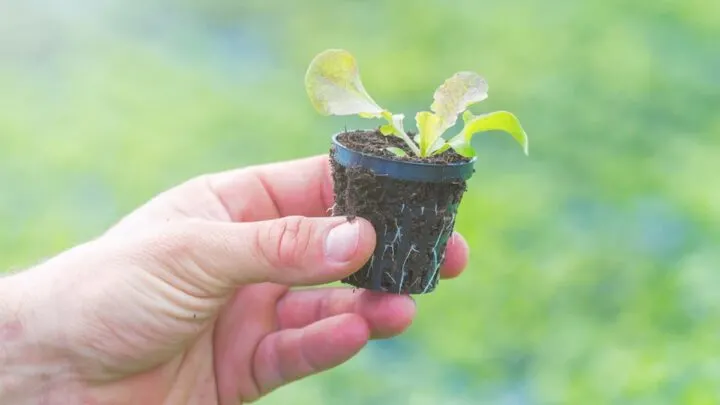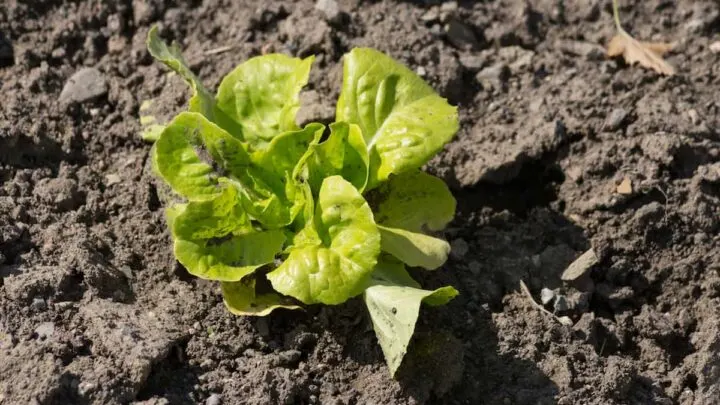Lettuce is a glorious cool weather plant to grow, and depending on where one lives, the crop might be able to grow in spring, summer, fall, or winter. In temperate climates, like the Pacific Northwest, lettuce may be grown 12 months out of the year with more shade in warmer months and more sun in cooler months. In warmer southern climates, lettuce may only be grown in the spring and fall, and in colder northern climates, lettuce may be a summer crop. Knowing and following the guidance for growing lettuce based on the plant hardiness zone you live in is crucial to a successful lettuce harvest. Combining that practice with this guide to transplanting lettuce seedlings and care should result in happy and healthy lettuce plants.
Lettuce seedlings are typically ready to be transplanted after about a month of seedling growth or when they are at least 2 inches tall. If transplanted outdoors or in a greenhouse, temperatures should be consistently between 45 and 70 degrees Fahrenheit. This is usually the two week period around the last spring frost or in shade heavy areas in late August for more seasonal climates.
Read on to learn more about transplanting and caring for lettuce seedlings.

Timeline for Lettuce Development & Transplanting
As discussed, each gardener’s specific timeline for transplanting lettuce seedlings will be specific to the geographic area in which they live. However, there are easy identifiers for all lettuce plants, regardless of growing zone, to help signal that it is time to transplant.
The right combination of light, moisture, and temperature are all needed for lettuce seeds to come to life from dormancy. Check out the next table for these identifiers and steps to take:
| Stages of Lettuce Development | Planting Timeline & Visual Identifiers |
| Planting Seeds | Plant lettuce seeds a few weeks prior to any cool but mild temperature season. This differs depending on the environment in which one lives. Seeds may be started earlier, indoors with a grow light, in any climate. Regardless of weather, always plant lettuce seeds in soil approximately 1/4 – 1/2 inch deep. |
| Seed Germination | Lettuce seeds need temperatures of 40 – 80 degrees F to stimulate life. If temperatures exceed 80 degrees F seeds may enter thermal dormancy, meaning hot temperatures are causing seedlings to not grow. Germination time frames may vary depending on the lettuce variety but on average this takes anywhere from 7 – 20 days after planting seeds. |
| Seed Development | Once seeds have germinated the plant will begin to develop roots and leaves. |
| Time to Transplant | Lettuce seedlings are usually ready to transplant when they have been growing for around 4 weeks or when lettuce leaves are 2 – 3 inches above the soil. Outside temperatures must be between 45 – 70 degrees F for transplanting. Before fully transplanting seedlings outdoors they should be hardened* for about a week. *learn more about hardening later in this article. |
| Plant Development | Ideal temperatures for lettuce plant development are the same as transplanting, 45 – 70 degrees F. If temperatures drop significantly below or above this range plant health may be affected. |
| Harvesting | If growing lettuce in the spring it’s important to harvest before temperatures become too hot (80 degrees F or higher). Leaf lettuce: Can be harvested frequently when lettuce leaves are healthy and large enough to not negatively affect the size of the plant. Heads of Lettuce: Can be harvested approximately 65 days after transplanting depending on the variety. This timeline may increase and require gardeners to sacrifice of the size of the lettuce head if temperatures get hot too quickly. If the outer leaves of the head are starting to brown or curl that is a sign temperatures are getting too hot for the plant. |
| Bolting | Bolting is common with spring lettuce crops as temperatures increase. It’s identifiable when the plant stops producing leaves and instead puts growing energy into a treelike stalk. At this point leaf growth stalls and some lettuce varieties will exude a milky substance when remaining leaves break off. If all other signs go unnoticed, bolting lettuce can also be identified by its bitter change in flavor. Once lettuce bolts it can be left to seed the growing area for a future lettuce crop or removed to prep the growing area for a new plant crop. |
Methods of Transplanting: Indoor vs. Outdoor
While the ideal environment for any plant is outdoors, some growing locations’ light and temperatures are not ideal for lettuce when the gardener wants it to grow. Depending on your plant hardiness zone and the gardener’s desire to grow lettuce, indoor or outdoor transplanting and growth may be an option.

Indoor
If transplanting lettuce indoors, the plant needs to have an appropriately sized container and a sufficient light source for full growth. It is also essential for gardeners to know that while leaf lettuce may grow indoors successfully, it is unlikely that a head of lettuce will reach its full potential with indoor growth.
It is ideal to have a grow light if starting lettuce indoors during late winter and early spring when daylight hours are shorter. However, leaf lettuce will grow successfully in a well lit window once days have grown longer. Growing lettuce indoors could be the best method in growing zones that are less temperate and lean towards longer seasons of hot or cold temperatures.
Challenges to growing lettuce indoors could be a lack of light if natural light is not conducive to your indoor space and the impact on pets or small children. In my home, my family’s cats would never allow lettuce (or any plant) to survive indoors without causing it constant turmoil. So, in essence, know your pets, your children, and any other in-home obstacles before attempting to grow lettuce indoors.
Outdoor
Lettuce will thrive when transplanted outdoors from seed to harvest if temperatures are right. Although we are focusing on the practice of transplanting in this article, gardeners are also often successful in growing an abundant lettuce crop by sprinkling seeds onto healthy, cultivated soil and allowing nature to do the work.
Regardless of how your lettuce plants make their way into the outdoors, they will thrive in areas with balanced sunlight and shade combined with mild temperatures.
In addition to the ease of growing lettuce outdoors (if your environment allows), gardeners will find a much more abundant harvest with a lettuce crop growing under natural sunlight than indoors, where light is more filtered. The gardener’s green thumb rule should always be to plant and grow outdoors whenever possible.

Tips To Care For Lettuce Seedlings
All plants are in their most fragile state as seedlings. Lettuce especially carries these challenges, as it remains a somewhat delicate plant in maturity. It’s crucial to follow best practices for appropriate handling, watering, lighting, and hardening (pre-transplant) for optimum harvest potential.
Handling
The most valuable word to focus on when handling lettuce seeds is gentle. If transplanting, scoop the seedling with its soil from below the root. Sometimes multiple seedlings may be combined in one container and need to be separated.
When this situation occurs, it’s essential to find where the root balls exist and carefully pull them apart for transplanting. Always keep the seedling cupped in your hand when between containers or the earth.
Watering
Lettuce seedlings require steady watering that is not too heavy or too light. A good rule to follow is to maintain seedlings hydration so they feel and appear consistently misted with moisture on the plant, soil, and roots.
Once lettuce seedlings develop into stable, mature plants, regular watering is still essential for plant development and harvest. If temperatures are near 80 degrees F, combining shade elements with consistent watering is essential to maintain lettuce seedling health.
Light Source
The light needs for lettuce seedlings can be tricky and sometimes dependent on temperature. If seedlings are developed, indoor lighting can be very controlled with grow lights or movement between well lit windows.
Grow lights are ideal for lettuce seedlings in the early winter and springtime periods when temperatures may still be too cold outside. When used appropriately, grow lights can help develop solidly healthy seedlings that are trained for warmer weather.
If developing lettuce seedlings outdoors, it can get a bit more complicated. In this case, the gardener needs to rely on the sun’s direction to the growing location, which constitutes the daily amount of sun and shade. If temperatures increase during outdoor development, lettuce seedlings may require more shade, so there is time for them to recover from exposure to extreme light.
The most valuable rule to follow when providing light to one’s lettuce seedlings is that the plants can handle more light in cooler temperatures, whereas hotter temperatures will require more shade.
Hardening
Before lettuce seedlings are transplanted, it is crucial that the plants are hardened. Novice gardeners may wonder what this term means. Generally, hardening means gradually exposing plants to true sunlight and natural temperatures before fully planting them outdoors.
Regarding lettuce seedlings, it is essential to take plants out for a few hours a day, in natural sunlight, before fully transplanting them in an outdoor location. If seedlings are not hardened before transplanting, they may go into shock. This shock can stunt their growth and result in other unfavorable effects on the seedlings.
Final Thoughts on Growing Lettuce
While this article focuses on transplanting, if the growing zone allows, it is best to direct sow lettuce seeds into the earth rather than starting them in containers and transplanting. As an active at home gardener myself, I have had occasions where starting and then transplanting lettuce seeds has been very successful and resulted in an abundant harvest.
Other times that has not always been the case. This spring, my lettuce starts did not succeed indoors for several reasons. So instead, I scattered lettuce among other greens seeds such as arugula, collard greens, and bok choi across the garden area where I had originally intended to transplant.
Wouldn’t you know it, here in early May, that seed scattering has resulted in an abundant harvest of lettuce and greens. Based on this small anecdote, my final tips for you are to follow the guidelines for your growing zone and the instructions provided with the seeds you purchase. But when all else fails, when it comes to lettuce, scatter seeds, and you may be surprised with a happy crop and healthy harvest.

Hi there, my name is Allie and welcome to my blog; GareningWithAllie!
Much of what you see written here is just our personal experiences with gardening. Along with the content I write here, there is also a unique collection of gardening topics covered by some of our close friends. I hope you find everything you read here to be helpful, informative, and something that can make your gardening journey the most lovely experience ever! With that said, Happy Gardening!
